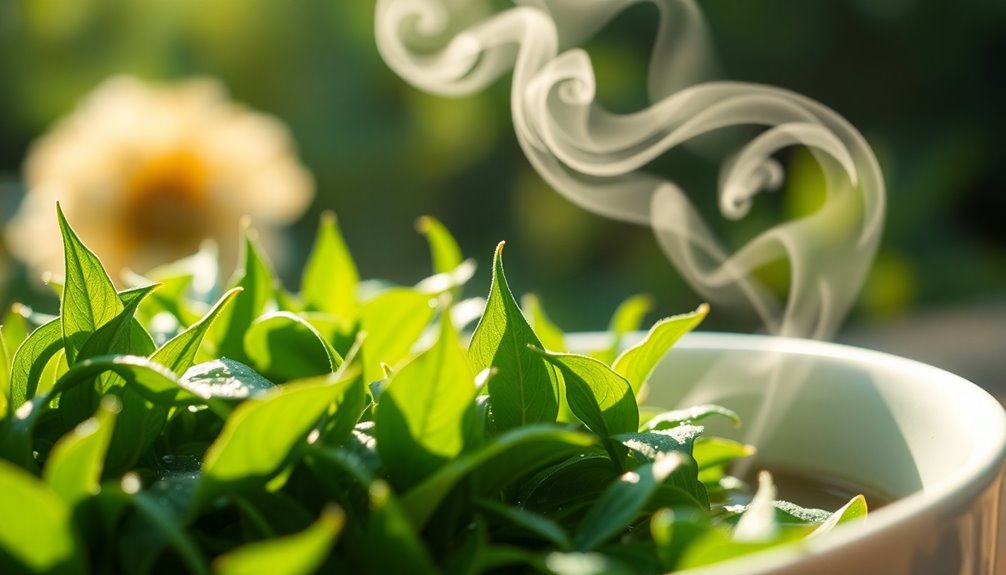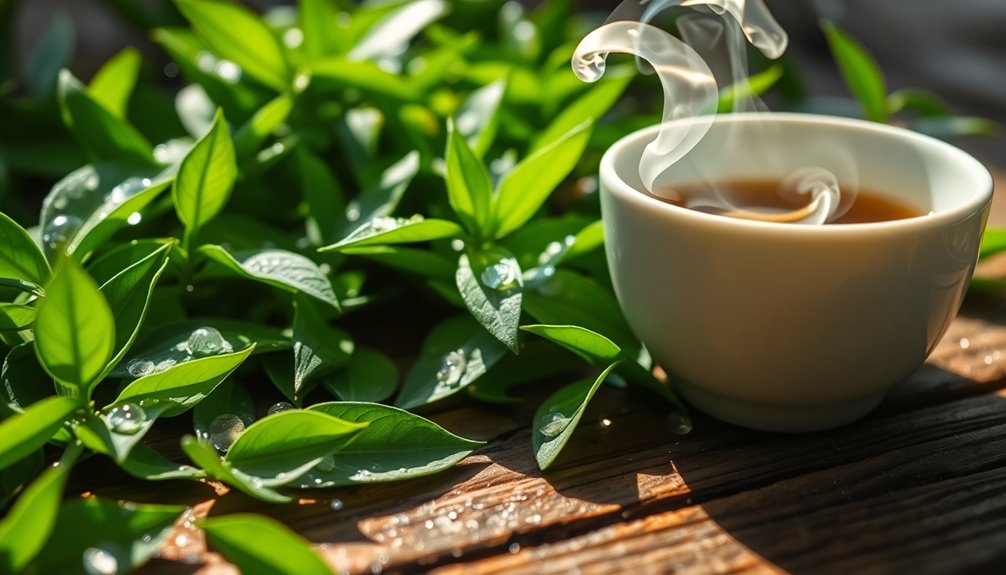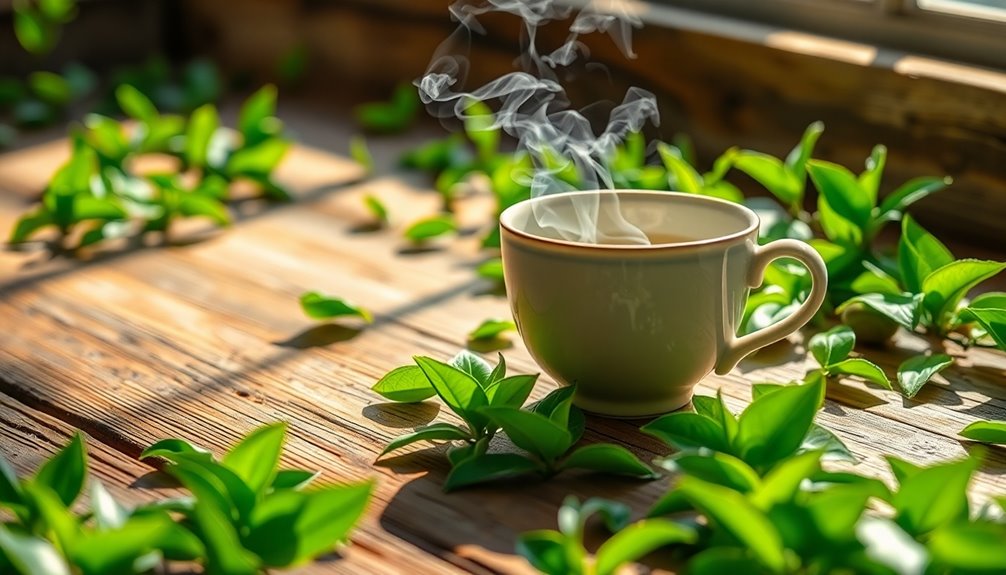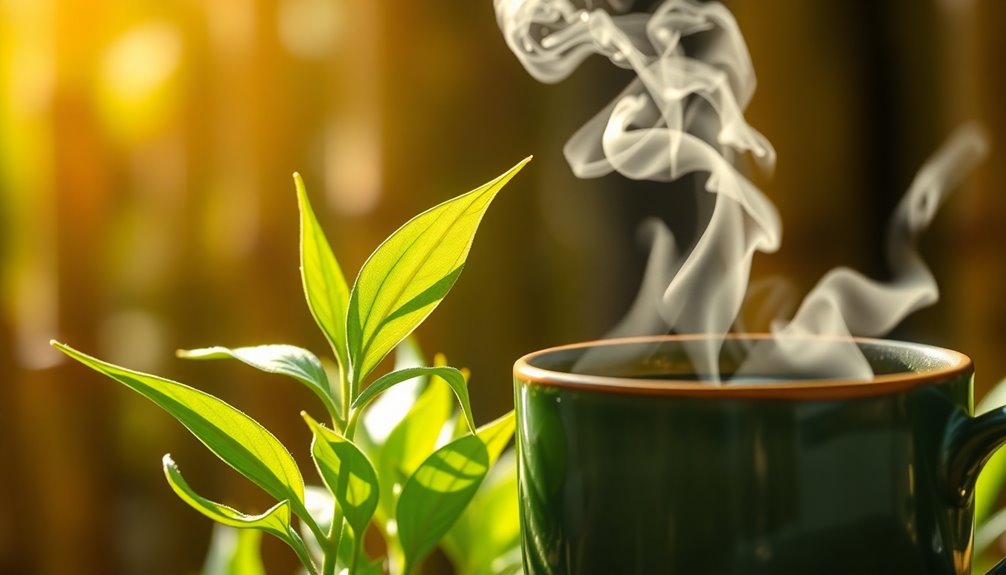Green tea smells fresh and uplifting, blending earthy, grassy, and floral notes that evoke a sense of tranquility. You might notice hints of jasmine or orchids beneath its vibrant aroma. Japanese varieties often carry a muskiness reminiscent of seaweed or even cooked cabbage, adding uniqueness to the fragrance. Proper brewing enhances these notes, allowing you to experience a balance of sweetness and herbal undertones. This scent can transport you to serene landscapes, deepening your connection to health and wellness traditions. If you find this intriguing, you'll want to explore how its scent affects mood and culture even further.
Key Takeaways
- Green tea has a fresh and uplifting aroma, characterized by earthy, woody, and grassy notes.
- Floral undertones, often reminiscent of jasmine or orchids, complement the overall fragrance profile.
- Japanese varieties may exhibit a distinct muskiness, evoking scents similar to cooked cabbage or seaweed.
- Citrus, herbal, and subtle sweetness elements create a balanced and complex aroma.
- The aroma of green tea symbolizes tranquility and wellness, enhancing meditation and mindfulness experiences.
Introduction

When you take a moment to breathe in the aroma of green tea, you're greeted by a refreshing scent profile that's both uplifting and invigorating. This unique fragrance captures crisp, earthy, and woody notes that evoke a sense of tranquility and freshness. As you explore the aroma of green tea, you may notice a distinct muskiness, reminiscent of cooked asparagus or seaweed, particularly in Japanese varieties. This comes from the presence of Dimethyl Sulfide (DMS) and adds a layer of complexity to the scent.
You might also encounter complementary notes like citrus, floral, and herbal elements, which create a balanced and harmonious scent experience. These fragrances enhance the overall aroma of green tea, making it more inviting. While some may find the strong and distinct scent of authentic green tea off-putting compared to lighter, flavored alternatives, it's this authenticity that connects you to nature, evoking imagery of lush landscapes and vibrant foliage. Ultimately, the aroma of green tea captures a moment of serenity, encouraging you to take a deep breath and appreciate the refreshing essence it brings to your senses.
Description of the Smell

As you inhale the aroma of green tea, you'll immediately notice its fresh and uplifting scent, characterized by a blend of earthy and woody notes. This invigorating scent captures the essence of green tea leaves, transporting you to lush landscapes and vibrant foliage. The fragrance notes often evoke a sense of cleanliness and purity, making each sip feel refreshing.
Authentic green tea carries a distinct muskiness that some might liken to cooked cabbage or seaweed, especially in Japanese varieties that are steamed. This unique aspect adds depth to the aroma, enhancing its complexity. In certain green teas, high concentrations of dimethyl sulfide (DMS) contribute nuanced characteristics, reminiscent of cooked asparagus and even oceanic hints.
Source and Composition

The source and composition of green tea significantly influence its aroma and overall flavor profile. When you brew green tea, you'll often notice its unique green tea smell, characterized by a fresh, earthy scent. This aroma features subtle green tea notes that may remind you of cooked vegetables like asparagus and seaweed. These scents arise mainly due to the presence of Dimethyl Sulfide (DMS), which is more pronounced in Japanese green teas due to their steaming process. This method enhances the DMS content, giving the tea a distinct seaweed aroma that you might not find in Chinese varieties.
You may encounter a musky scent in authentic green tea, which could be off-putting for some. However, this aroma indicates the tea's potent flavor and potential health benefits. As you experience the tea scents, you might find that they evoke imagery of fresh plants and lush landscapes, reflecting the invigorating nature of green tea. Keep in mind that cultural perceptions of this aroma can vary, especially in Western markets, where some might associate its authentic scent with less desirable qualities compared to flavored or diluted versions.
Typical Scenarios or Environments

A cup of green tea can transform any space into a serene oasis, evoking the scent of fresh foliage and vibrant landscapes. You might find yourself in a cozy café, where the air is filled with an uplifting aroma that often draws you in. The smell of brewed green tea here is clean and refreshing, encouraging you to unwind and savor the moment.
In traditional settings like Japanese tea ceremonies, the aroma enhances the tranquil atmosphere, making it a sensory experience you won't forget. Imagine sitting in a peaceful room, surrounded by soft sounds and the gentle fragrance of green tea.
Outdoor environments amplify these scents, too. Picture yourself in a lush garden, where the earthy and herbal notes of green tea blend seamlessly with the gentle breeze, carrying the fragrance of fresh herbs and grass.
In coastal regions, especially near tea processing facilities, green tea can take on unique oceanic aromas, reminding you of the sea. Each setting offers a different experience, but the essence of green tea is constant—inviting, fresh, and uplifting.
Emotional or Cultural Associations

Throughout history, green tea has been entwined with feelings of tranquility and mindfulness, inviting you to pause and reflect. The smells of green teas often evoke a sense of calmness, encouraging you to embrace relaxation. In many cultures, especially in Japan, the unique aroma of green tea carries deep emotional significance, linking it to coastal landscapes and the term "Ooika." This connection enhances your sensory experience as you sip on a cup.
However, in Western cultures, the muskiness of authentic green tea can sometimes be stigmatized. Many people gravitate towards sweeter alternatives, overshadowing the appreciation for its genuine scent. Despite this, tea enthusiasts celebrate the complexities of green tea's aroma, fostering a sense of community among those who cherish its unique olfactory characteristics.
Moreover, the fresh, earthy scent of green tea has become synonymous with health and wellness, embodying ideas of purity and vitality. As you enjoy your cup, remember the emotional and cultural associations that enrich your experience, allowing you to connect with a broader narrative that transcends mere taste.
Health or Safety Considerations

Many people enjoy green tea for its distinctive aroma and health benefits, but it's important to be aware of certain health and safety considerations. While consuming authentic green tea can offer numerous health benefits, including antioxidants that promote overall well-being, the unique muskiness of its aroma can be off-putting for some. If you're used to milder flavors, this strong scent might not be appealing.
Additionally, the steaming process used in Japanese green tea enhances compounds like Dimethyl Sulfide (DMS), which may contribute to its seaweed-like aroma. For sensitive individuals, this could lead to potential allergic reactions. Overconsumption is another concern; too much green tea can result in caffeine sensitivity or digestive discomfort, especially if you're not accustomed to its potency.
Be cautious with commercially available green teas, as many contain added flavors that mask the authentic scent and taste. This can mislead you about the true health benefits of pure green tea. Ultimately, while the whole world enjoys green tea, understanding these health and safety factors will help you make informed choices for your well-being. Additionally, incorporating anti-inflammatory herbs like turmeric may enhance the health benefits of your green tea routine.
Final Thoughts

Green tea offers a unique sensory experience that goes beyond its taste, inviting you to explore its captivating aroma. When you take a moment to inhale its scent, you'll notice fresh, uplifting Green Notes that evoke imagery of lush landscapes and vibrant foliage. This invigorating aroma often smells like earl, with earthy and woody undertones that add depth to the experience.
As green tea continues to grow increasingly popular, its distinct fragrance plays a significant role in its appeal. You might find that the scent promotes tranquility and well-being, making it a favored choice not only for tea enthusiasts but also in the world of perfumery. While some may be put off by the strong muskiness of authentic green tea, others appreciate its complexity.
In essence, green tea's aroma is a celebration of nature, with hints of cooked asparagus and seaweed adding to its unique character. Additionally, many appreciate the health benefits of flower teas like hibiscus, which can complement the green tea experience. Whether you enjoy it for its health benefits or simply for the serene experience it provides, embracing the aroma of green tea can elevate your daily rituals and enhance your overall appreciation of this beloved beverage.
Frequently Asked Questions
How Do You Describe the Smell of Green Tea?
When you describe the smell of green tea, you might say it's fresh and invigorating. You'll notice earthy, woody notes that create a crisp, clean aroma. Sometimes, it has a unique muskiness that can be off-putting for some. If you're exploring Japanese varieties like sencha, you might even detect hints of cooked asparagus. Floral undertones, like jasmine or rose, can enhance the experience, making it feel elegant and natural.
Does Green Tea Have a Fishy Smell?
You might be surprised to learn that green tea doesn't have a fishy smell. Instead, it offers fresh, vegetal, and earthy aromas, often likened to grass or seaweed. Some varieties, especially Japanese ones, can have a distinct scent due to compounds like dimethyl sulfide, which may evoke oceanic notes. However, these aren't fishy. The aroma can be strong, and if you're not familiar with it, you might misinterpret it as something off.
What Do Teas Smell Like?
When you explore different teas, you'll notice a variety of aromas. Black teas often smell rich and malty, while oolong can be floral or fruity. Herbal teas may evoke scents of spices or sweet fruits. Each tea type has its unique character, influenced by factors like processing and ingredients. As you brew, pay attention to how the aroma evolves, enhancing your overall experience and connection to the tea's origin and flavor profile.
What Is Scented Green Tea?
Scented green tea is a delightful twist on traditional green tea. You'll find it infused with natural flavors like jasmine, mint, or citrus, which elevate its aroma. When you brew it, the infusion process blends dried flowers, herbs, or fruit peels with the tea leaves, giving you a complex scent experience. This makes scented green tea appealing for both casual drinkers and enthusiasts who appreciate the added fragrance along with the health benefits.









